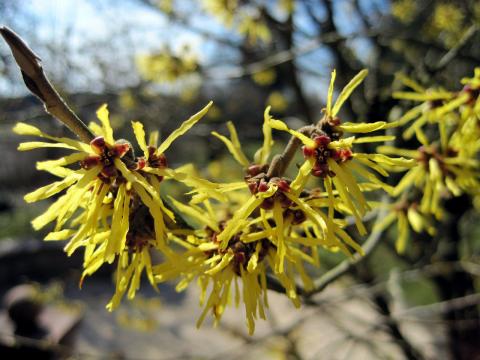Looking for Witch Hazel

On a walk in the Grafton County Farm forest the other day, amid the gray trunks and remaining dull orange leaves of the oaks and beeches, some small bright yellow flowers stood out. Flowers in November? They belonged to the witch hazel, an abundant shrub on the county forest.
Description, Range, Natural History
American Witch Hazel, Hamamelis virginiana, is a woodland shrub native to eastern North America. It ranges from Nova Scotia to Florida, and from the lake states to eastern Texas. The plant grows well on medium to fine textured soils of moderate fertility, and is intermediate in shade tolerance. In other words, it likes not too much shade and not too much sun.
Being a shrub and not a tree, witch hazel typically grows to 12 to 15 feet tall, and occasionally reaches 20 to 30 feet. It usually grows in a dense, multi-stemmed form. The bark is smooth, and light brown in color with lighter spots. The leaves are oval with wavy, scalloped edges and are alternate in pattern.
In addition to flowering after most trees and shrubs have shed their leaves, witch hazel has an interesting way of spreading its seeds. After being dormant over winter, the brown seed capsules develop to maturity the following growing season. When fully mature in the fall, the capsule bursts, sending two glossy black seeds flying ten to twenty feet away. This strategy increases the chances of the seeds germinating somewhere out from under the shrub’s own shade. Because witch hazel needs some sun to germinate, if the seeds simply fell off the shrub onto the ground, conditions would be too shady for germination.
Uses
Forked limbs from witch hazel were reportedly used as dowsing rods. According to the US Forest Service, the name witch hazel was possibly derived from this use. “Wicke” is Middle English meaning “lively”, and “wych” means “bend” in Anglo-Saxon. A dowsing rod allegedly bends and points toward the source of water when found.
Another use of witch hazel is as a topical treatment for skin problems. Native Americans used an extract of the twigs and bark to treat minor wounds and skin irritations. The first commercially available witch hazel was produced by Thomas Newton Dickinson in the mid-1800s. His company, which is still in existence today, distributes and markets witch hazel-based products for skin and personal care. The company harvests witch hazel in the fall through early spring and brings it to their facility where it is distilled in a proprietary process. The branches left over after distillation are chipped for landscape mulch.
Look Closely
Witch hazel is not to be confused with the wild hazelnuts also native to our forests – beaked hazelnut and American hazelnut. The hazelnuts are actually in the birch family – Betulaceae – while witch hazel is in a different family called Hamamelidaceae.
If you’re in the woods in late October and early November and see some small, bright yellow flowers, it’s most likely the witch hazel adding a last bit of color to an otherwise somber landscape.
